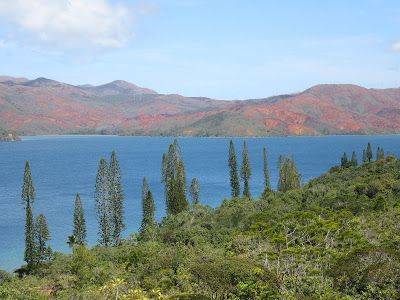One mantra of
cruising sailors is that we are not on vacation.
Too many things go
wrong with boats and weather, to say nothing of the general lack of
conveniences, to be carefree. Our time in New Caledonia’s Loyalty
Islands was a rare and welcome exception. Nothing was broken, the
weather was reasonably cooperative, and we felt—like we were on
vacation!
Ouvea
Ouvea is a low
narrow island, 15 miles of white crescent beach with a necklace of
tiny islets on an outer reef aptly named the Pleiades. The blue hues
of the lagoon defied description, the sand was soft as powder, and we
usually had the whole place to ourselves. Paradise found…
 |
| Sundowners on the beach, woo hoo! (in case you're wondering, that bottle of duty free gin lasted a very long time) |
 |
| Turtles were large and curious |
We visited caves
along a cliff on the windward side of the island, accessed by
wading across a salt water river then climbing a ladder the local
people use.
 |
 |
| After providing shelter for villagers during a cyclone, an altar was placed in this cave |
 |
| The pouch around our guide's neck, woven from traditional fibers and decorated with sea shells, held his cell phone! |
Mouli was the most
traditional village we saw anywhere in New Caledonia. The French
government has provided electricity, phone service and running water
almost everywhere, but the people here still live in cases
(conical thatched huts).
 |
| The chief's grande case is surrounded by a fence of large logs and has the most decorated ornament at its peak |
Lifou
The island of Lifou is not far from Ouvea, but its geology is radically different.
High cliffs predominate, with coral gardens along the base of the
cliffs.
A local family adopted us for a day, and we got a chance to
experience how the Kanaks are balancing aspects of their traditional
culture with Western influences.
 |
| We were invited for a lunch of fruit, bread and sausage, on the porch of their small European-style home (painted orange, which is a very popular color for both clothes and houses) |
 |
| However, they also spend a great deal of time in their traditional case, which is right next door to the other house |
 |
| Sleeping mats, a drying rack for fish, and popping corn for the fire (the fire pit, not in the photo, is right in front of our feet) are visible inside the case |
On Lifou, the living arrangement of both styles of homes side by side
is very common




























